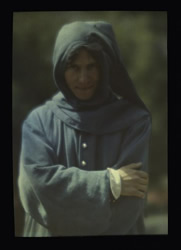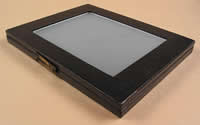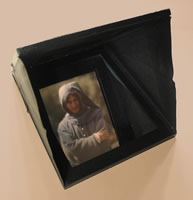Featured Acquisition: Autochrome portrait of Percy MacKaye by Arnold GenthePercy MacKayeAmerican playwright Percy MacKaye (1875-1956) appears here as the poet Alwyn, “friend of all,” in Sanctuary: A Bird Masque. MacKaye was a proponent of communal civic theater and a nature lover. He wrote this masque as a public pageant for the dedication of the Bird Club sanctuary in Meriden, New Hampshire. The play, written in verse, told of a hunter’s redemption by his prey, the Bird Spirit. At a time when demand for feathers in hats and other products was harming entire species, the play helped promote the wild bird conservation movement. President Woodrow Wilson, who was summering nearby, attended the first performance on the evening of September 12, 1913. Under the patronage of First Lady Ellen Wilson, the cast included members of the Cornish Art Colony and other local participants. The colorful pageant, staged in an improvised outdoor amphitheater, featured rich costumes, music, song, and dance. The performers included the Wilson’s daughters, Eleanor, in the leading role of Ornis (the Bird Spirit) and Margaret, who sang the opening Hermit Thrush song. Master photographer Arnold Genthe (1869-1942) was well known in both literary and art circles. In his autobiography, he recalled photographing all the Sanctuary participants in color at the rehearsal. His photographs illustrated the published play in both color and black-and-white. The Library’s Arnold Genthe Collection has additional photographs related to the play. [View Genthe photos related to the Sanctuary] [More information on the Genthe Collection] Autochromes
The soft color effects of the autochrome appealed to Genthe and other art photographers working in the early 1900s. Louis Lumière (1864-1948) invented and patented the autochrome in France in 1904. In 1907, Louis and his brother August (1862-1954) began to distribute autochrome plates, and photographer Alfred Stieglitz (1864-1946) soon popularized the process in the United States. Autochromes remained in active use into the 1930s when new types of color film, such as Kodachrome, replaced them. The autochrome process involved the adherence of red-orange, green, and blue-violet potato starch grains to a glass plate, which was then coated with a light sensitive gelatin-bromide emulsion. After exposure in a camera and development, the plate became a one-of-a kind positive image. People viewed an autochrome by holding the plate up to a light source, projecting the image onto a surface, or looking at a mirror reflection in a special device called a diascope. The MacKaye autochrome is 7 x 5 inches and has its original diascope viewer. The Library’s 2007 purchase of this arresting portrait of Percy MacKaye celebrates the 100th anniversary of the commercial availability of autochromes. A search for autochromes by Arnold Genthe in the Prints & Photographs Online Catalog displays many additional examples of this first practical process for color photography. [View more autochromes in the Genthe Collection] |
|||
| The
Library of Congress >> Researchers October 22, 2010 |
Legal | External Link Disclaimer |
Contact
Us: Ask a Librarian |


